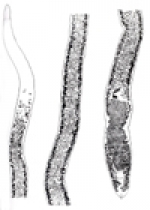NEIHPID
North-East India Helminth Parasite Information Database
Recently added
Parasites
Molecular Data
Lytocestus assamensis (Tandon, Chakravarty and Das Tandon, Chakravarty and Das)
Taxonomy
Platyhelminthes »
CESTODA »
Caryophyllidea »
Lytocestidae Wardle et McLeod, 1952 »
Lytocestinae Satpute et Agarwal, 1980 »
Lytocestus Cohn, 1908 »
Lytocestus assamensis, Tandon, Chakravarty and Das 2005
Host
Clarias (batrachus)(L.)
Habitat
Intestine
Locality
Guwahati (Assam), Shella (Meghalaya)
Description
Body very long, slightly tapering anteriorly, 25.54 -50.82 mm in length, 1.32 -4.62 mm in maximum breadth at level of cirrus sac; body proper divided into cortex and medulla by two layers of longitudinal muscles. Scolex undifferentiated, smooth and unarmed, with bluntly tapering extremity; well developed gland cells present, with distinct zone of dense aggregation 3-4 mm from anterior extremity. [This distinct glandular region provides the only clue for distinguishing and delimiting the scolex region from the neck; limits of the latter otherwise are not well demarcated from the rest of the body proper]. Testes numerous, 266-565 in number, occupying medullary region, ovoid, larger than vitelline follicles; cirrus sac prominent, opening separately from female genital pore; external seminal vesicle present. Ovary bilobed, bent inwards in shape of inverted A, ovarian wings joined by isthmus, whole ovary cortical; Mehlis’ gland well developed, behind isthmus; uterus glandular, extending from in front of isthmus anteriad beyond lateral horns of ovary; vagina distinct, joining terminal end of uterus to open unitedly to exterior at utero-vaginal pore immediately posterior to male opening. Vitelline follicles cortical, mainly concentrated in lateral fields generally not spreading throughout whole peripheral medulla of testicular zone, commencing from pretesticular region, extending posteriad up to level of cirrus sac. Excretory pore at terminal hind end. Eggs 0.03 -0.05 x 0.02 -0.03 mm in size, smooth, operculate (as confirmed from the observations of eggs ex utero under phase contrast).
Remarks
While ascertaining its specific status and on comparing it with the known forms of Lytocestus, the present form stands close to L. longicollis in sharing the characters such as the undifferentiated scolex, the inverted A-shaped ovary and the uterine coils extending beyond the anterior horns of ovary. However, it differs from the same in not possessing a receptaculum seminis, which is the characteristic feature of L. longicollis. Besides, the size of the body, testes and vitellaria and the distribution of vitellaria within the testicular field in the present form further distinguish it from L. longicollis in which the vitellaria are confined to the lateral fields.
On comparison with L. parvulus, the present form distinctly differs in not possessing five rows of vitelline follicles. The size and shape of the testes and vitellaria, which are much larger and ovoid in the present form, are the characters that differentiate it from L. filiformis. While the present form is broad and flat occupying the full width and considerable length of the host’s intestine, the body is much slender and elongated in L. javanicus.
On comparison the present form differs from L. clariae in possessing distinctly apart genital apertures and non-spinous eggs, and from L. attenuatus in the distribution of testes and vitellaria that are intermingled and not confined to the lateral fields, and in the extent of uterine coils that are limited only up to the ovarian isthmus and not beyond.
Specific Diagnosis
Body very long; scolex undifferentiated, without terminal introvert; long neck; inverted A-shaped ovary; uterine coils not extending beyond ovarian isthmus; external seminal vesicle present; vitellaria mainly in lateral fields of testicular zone.
Etymology
Named after the state of Assam from where the fish hosts were first collected.
Helminthological collections record
NEHU/Z - CF/2
Specimen Type
Holotype: IV/ERS 286; Paratype: IV/ERS 287; T. S. series IV/ERS 288 in Zoological Survey of India (E



.jpg)
